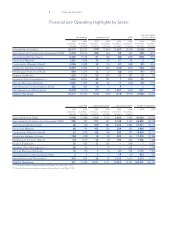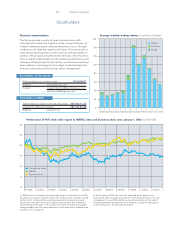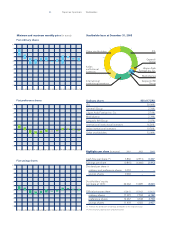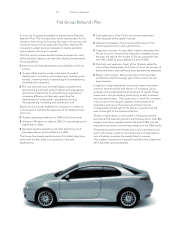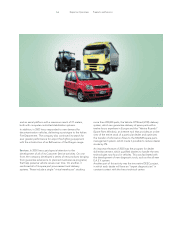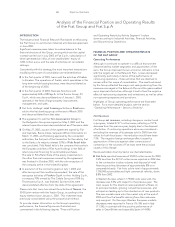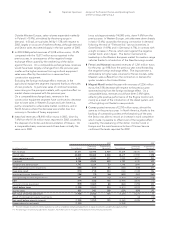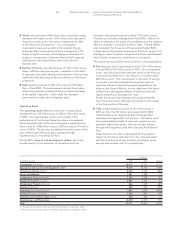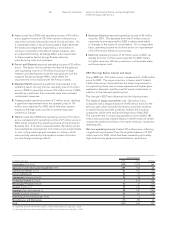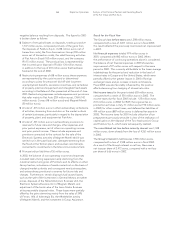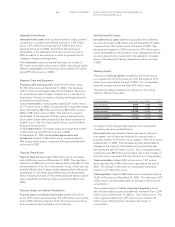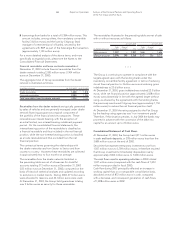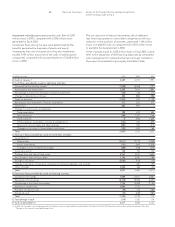Chrysler 2003 Annual Report Download - page 20
Download and view the complete annual report
Please find page 20 of the 2003 Chrysler annual report below. You can navigate through the pages in the report by either clicking on the pages listed below, or by using the keyword search tool below to find specific information within the annual report.
19 Report on Operations
Mobility allowances were also used to achieve the downsizing
targets set forth in the staff restructuring plans of the other
Group Sectors. One of the tools that can be used in this area
is long-term mobility allowances. These allowances, which were
made available under a law enacted in April 2003, are provided
over a longer period than regular mobility benefits. A total of
2,400 employees of Fiat Group companies and 181 Teksid
employees were eligible for coverage under this benefit
program.
Outside Italy, staff redundancies were handled primarily through
programs developed with the agreement of local trade unions.
The companies involved were: Irisbus (closure of a plant in
Mataró, near Barcelona, and of the Ikarus factory in Hungary);
CNH (restructuring of the Berlin facility and definition of a social
impact program for the closure of the Crepy factory in 2004);
Magneti Marelli (staff reductions at the Magneti Marelli Lighting
plant in Cannock, UK); and Comau (completion of the
redundancy procedure for Comau Estil).
As required under the applicable EU Directive, restructuring
issues, especially those that have a transnational impact, were
the subject of information and consultation with the members
of the Fiat Group European Works Council at the meeting of
the Restricted Committee in mid-March 2003 and at the annual
meeting on November 6 and 7, 2003. On that occasion, the
Company provided extensive information about its Relaunch
Plan, particularly with regard to its impact on employment levels
and the measures that will be used to handle redundancies.
In Italy, collective bargaining negotiations focused on the
National Collective Labor Agreement for Metalworking
Employees, which expired in December 2002. The new contract,
which was renewed after about four months of negotiations,
was signed by Federmeccanica, an organization representing
metalworking businesses, and all of the unions (FIM-CISL, UILM-
UIL and FISMIC), except for FIOM CGIL, which refused to sign.
The new contract, which covers about 70,000 Group employees
in Italy, sets wages for two years and work rule provisions for
four years. Under this agreement, employees were granted
monthly wage increases averaging 90 euros before taxes (45
euros on July 1, 2003, 24 euros on February 1, 2004 and 21
euros on December 1, 2004). The incremental compensation
for the first six months of 2003 was set at 220 euros before taxes,
payable in two lump-sum installments (115 euros in June 2003
and 105 euros in January 2004). When fully implemented in
2005, the contract package will have an impact on labor costs
of about 5% (about 2% in 2003 and 2.4% in 2004).
FIOM’s refusal to sign led it to adopt a posture of ongoing
unrest. This resulted in several strikes, but they were joined
by only a limited percentage of workers. The same low
participation occurred when strikes were called to protest
redundancy agreements.
Outside Italy, the main labor agreements included the signing
of annual collective contracts by most Fiat Group companies
operating in France. These contracts provide for annual wage
increases of about 2%. In Poland, where staff compensation did
not change in 2002, the employees of Fiat Auto received a wage
increase of about 3%. In Brazil, Fiat Automoveis SA-FIASA and
the local labor unions reached an agreement in June on the
payment of an annual bonus tied to company results and
negotiated a wage increase that is payable in advance of
the renewal of the industry-wide labor agreement.
Human Resources


